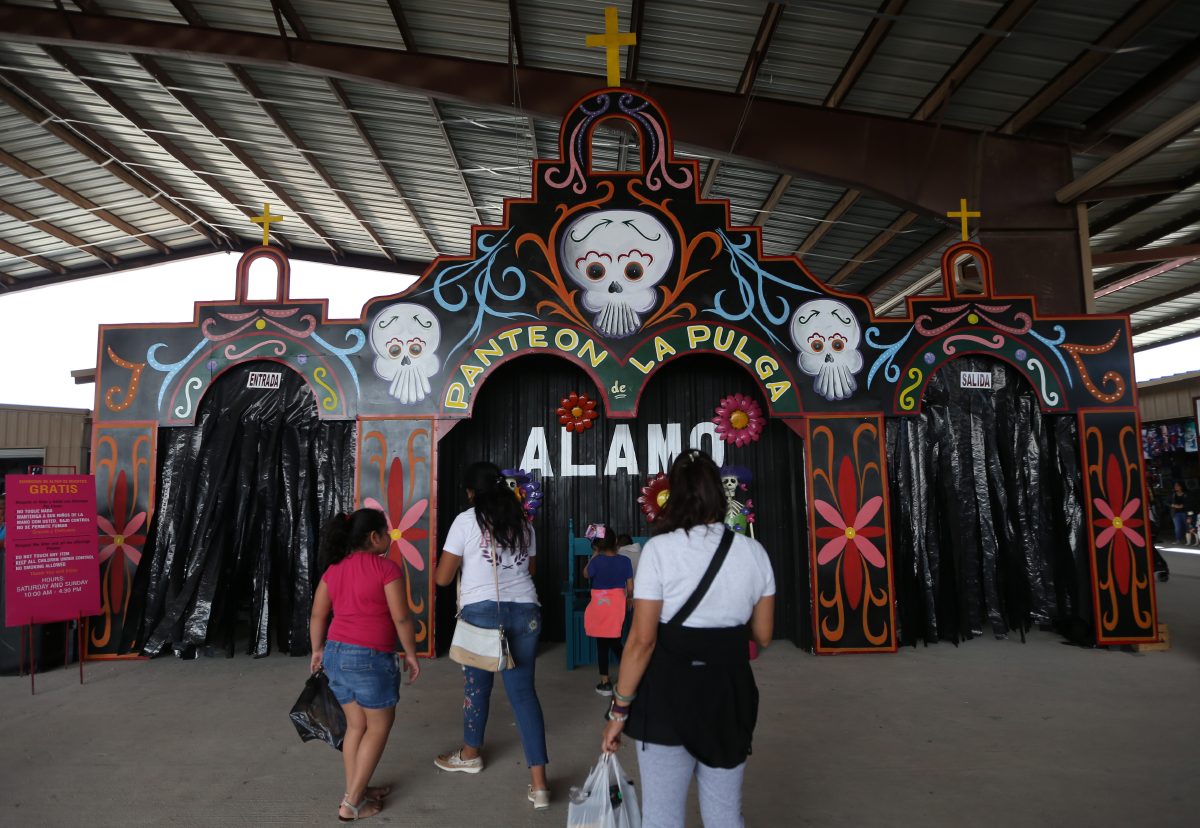HAMMER: Dearly departed or Traditions Aglow
Subhed: Second year living artwork is commissioned
BY MATT WILSON
STAFF WRITER
ALAMO— The Alamo flea market was as busy Sunday as it usually is, with shoppers strolling the aisles, Tejano bands blaring out music and people hawking everything from used tires to bananas.
Although the market bustled with life, a small section at the heart of the pulga was formally devoted to death earlier this month. On October 6, the market opened a display commemorating Día de los Muertos, the Day of the Dead, complete with an altar and skeletal catrinas.
Historically prevalent in Southern and Central Mexico, the traditions of Día de los Muertos have steadily crept northward, aided by films like Coco and the James Bond movie Spectre.
Traditionally, the holiday involves individuals gathering to commemorate and pray for deceased loved ones, bringing offerings of flowers and pastries to gravesites, and erecting altars at home or in public with gaudy skulls and depictions of La Catrina, a skeletal woman in her finest clothes.
Most of these traditions are represented in the display at the Alamo Pulga. The altar is separated from the rest of the market by black tarping, skulls illuminated by electric candles, loaves of bread made of glazed clay, photographs of deceased loved ones, and scores and scores of marigolds.
“Marigolds have very important symbolism, that’s why you see them a lot,” Manuel Ruben Cantu, the artist who built the display, said.
Cantu said he built his first Día de los Muertos display at the market last year.
“I had actually never made one before,” he said. “It was really popular last year, so the property owner decided to do it again. This year it’s twice as big.”
Although Día de los Muertos is traditionally celebrated from Oct. 31 to Nov. 2, the display in Alamo will be open to the public through November 3.
“The altar will be set for the rest of the month, so people will come in and leave their own photos of friends or loved ones,” Cantu said.
Nancy Kim, the property owner who commissioned the altar, said she sees it as a way to showcase and preserve Mexican culture.
“We decided to build the altar because the majority of the public who visit us are Hispanic and obviously we want to show them our traditions and how this Mexican tradition is so it won’t get lost,” she said in Spanish. “That is basically what inspired me to present this altar and show one of the most beautiful traditions in Mexico.”
Kim said the altar is also a way to honor and commemorate deceased people who were important to the market.
“In the Mexican culture, there are a lot of superstitions, where we don’t lose our contact with our loved ones once they pass away. Our beliefs as Mexicans is that on that specific day, we make a celebration in which we make an altar and have a party and they will supposedly come and celebrate with us,” she said. “We usually have some pictures on the main altar, the small ones are employees who have worked here and have passed away, and the person who is in the main picture is the founder of the Flea Market of Alamo.”
On Sunday, a steady stream of visitors wandered in and out of the market, peering at the displays and taking photos with the decorations. Kim said the altar has been warmly received.
“The people are very happy,” she said. “They like it a lot, and have enjoyed and appreciated the traditions and values of the altar.”
Stephanie Leal visited the display Sunday with her cousin. She said she enjoyed the altar.
“It was nice. It reminded me of Coco,” she said. “I’ve never (seen) anything like it.”
While Leal has never taken part in the tradition, she said her mother has, laying flowers on the graves of deceased loved ones in Mexico.
“It’s something different,” Leal’s cousin, Bobbie Leal, said. “I guess it just brings us closer to our culture. It’s something I’ve never gotten to experience before.”










